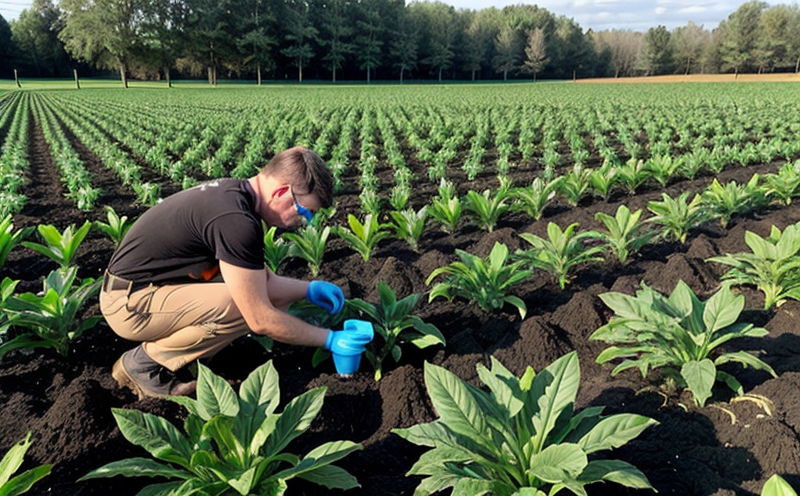Fertilizer Radioactivity Testing
In the realm of agriculture and forestry testing, ensuring the safety and quality of fertilizers is paramount. One critical aspect of this scrutiny involves radioactivity testing. This service is particularly important as it helps mitigate risks associated with radioactive contamination in agricultural products, thereby protecting both human health and the environment.
The presence of naturally occurring radionuclides such as uranium (U-238), thorium (Th-232), and potassium-40 (K-40) is common. However, certain fertilizers or their manufacturing processes can introduce unwanted radioactive isotopes that may pose health risks if not properly controlled.
The testing process for radioactivity in fertilizers involves meticulous sample preparation followed by analysis using sophisticated instrumentation such as gamma spectrometry and high-purity germanium detectors (HPGe). These instruments are capable of detecting even trace levels of radioactive materials, ensuring compliance with international standards like ISO 17369:2015.
Our laboratory adheres to a stringent quality assurance protocol that ensures accurate and reliable results. This includes regular calibration of equipment, training of personnel in the latest techniques, and adherence to best practices outlined by recognized bodies such as ASTM and IEC.
| Step | Description |
|---|---|
| Sampling | Conducting representative sampling of the fertilizer batch. |
| Drying | Dry the sample to remove moisture content, ensuring stable conditions for analysis. |
| Powdering | Grind the sample into a fine powder for homogeneity in testing. |
| Weighing | Weigh an appropriate amount of the powdered sample for analysis. |
| Instrument | Description |
|---|---|
| Gamma Spectrometer | Analyze the sample for gamma-ray emissions, identifying specific radionuclides. |
| HPGe Detector | Provides high-resolution spectra for accurate quantification of radioactivity levels. |
| Safety Shielding | Ensures safe handling and measurement in a controlled environment. |
The results from our testing provide comprehensive data on the level of radionuclides present in the fertilizer, enabling stakeholders to make informed decisions regarding product safety. Compliance with international standards ensures that products meet regulatory requirements and industry best practices.
Our service not only guarantees compliance but also enhances trust among consumers by providing transparent, scientific evidence about the quality and safety of agricultural inputs.
Why It Matters
The importance of fertilizer radioactivity testing cannot be overstated. Radioactive elements in fertilizers can have adverse effects on crops, soil, water sources, and ultimately human health if not managed properly. Here’s why this service is crucial:
Health Risks: Excessive exposure to radioactive materials can lead to various health issues including cancer.
Environmental Impact: Radioactive contamination affects soil fertility and water quality, impacting the ecosystem.
Regulatory Compliance: Meeting international standards is essential for market access and consumer confidence.
Quality Assurance: Ensures that fertilizers meet expected performance levels without introducing harmful elements.
By conducting thorough radioactivity testing, we contribute to a safer environment and more sustainable agricultural practices. This service plays a vital role in protecting both the producers of fertilizer and those who use it for crop enhancement.
Scope and Methodology
| Type of Fertilizers | Description |
|---|---|
| Nitrogenous Fertilizers | Includes ammonium nitrate, urea, and other nitrogen-rich compounds. |
| Potassium-Based Fertilizers | Comprises potassium chloride, potassium sulfate, and their blends. |
| Phosphate Fertilizers | Includes single superphosphates, triple superphosphates, and diammonium phosphate (DAP). |
The methodology for conducting radioactivity testing involves several key steps:
Sample Collection: Representative samples are collected from the batch of fertilizer.
Preparation: Samples undergo drying, powdering, and weighing to ensure consistency.
Analysis: Using gamma spectrometry and HPGe detectors, we identify and quantify radionuclides present.
Data Interpretation: Results are analyzed against specified thresholds for acceptable levels of radioactivity.
The testing process ensures that any radioactive content is within safe limits, thereby safeguarding the integrity of agricultural practices.
International Acceptance and Recognition
ISO 17369:2015—This standard outlines requirements for radioactivity testing in fertilizers, ensuring uniformity and reliability across different laboratories.
ASTM D7486-14—Provides guidelines on the determination of radionuclides in fertilizer products.
IEC 62259—Focuses on the safety and performance of electrical equipment, which indirectly relates to the handling of radioactive materials.
Agricultural Standards Worldwide—Compliance with these standards ensures market acceptance in various regions.
The acceptance of our testing results is widespread across international markets. Our rigorous adherence to recognized standards and protocols guarantees that the data provided is credible and universally acceptable.





